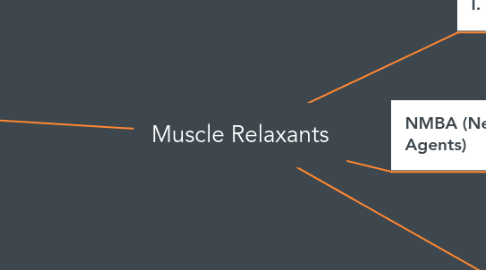
1. NMBA (Neuromuscular Blocking Agents)
1.1. Non-depolarizing NMBAs
1.2. Depolarizing NMBAs
2. II. Roles of Muscle Relaxants
2.1. Anti-Spasms (Anti-spasmodic)
2.1.1. Reducing Normal Tone (For Surgical & Respiratory Paralysis)
2.1.2. Treating Temporary Spasms
2.1.2.1. Rest & S/T Relief of muscle spasms
2.1.2.2. Often combined with NSAIDs or Acetaminophen (See Analgesics)
2.1.2.3. Very Helpful for PT Procedural Interventions both acute, as well as chronic
2.1.3. Anti-spasticity / Anti-rigidity
2.1.4. Dual Use - Anti-temporary spasms & anti-spasticity
2.2. Drug Types by Site of Action
2.2.1. Centrally Acting Drugs
2.2.1.1. Brain & Spinal Cord Acting
2.2.1.1.1. Benzodiazepines
2.2.1.1.2. Carisoprodol (Soma)
2.2.1.1.3. Cyclobenzaprene (Flexeril)
2.2.1.2. Spinal Neuron Acting
2.2.1.2.1. Zanaflex
2.2.1.2.2. Baclofen (Lioresal)
2.2.1.3. Others (Mechanism or Exact Site of Action Unknown but believed to be CNS level action without action on Skeletal Muscle
2.2.1.3.1. Methcarbamol (Robaxin)
2.2.1.3.2. Metaxalone (Skelaxin)
2.2.1.3.3. Chlorzoxazone (Paraflex)
2.2.1.3.4. Orphenadrine (Norflex)
2.2.2. Skeletal Muscle Acting
2.2.2.1. Spinal Cord Alpha Motor Neuron (LMN) Inhibitor
2.2.2.1.1. Botulinum Toxin
2.2.2.2. Direct Skeletal Muscle Inhibitor
2.2.2.2.1. Dantrolene sodium
3. I. Tonal Abnormalities
3.1. 1. When Normal Tone is undesirable
3.2. 2. Spasms
3.2.1. Temporary
3.2.2. Permanent
4. III. Relevance to Physical Therapists
4.1. Acute Pain Scenarios
4.1.1. Facilitates therapy
4.2. Post-surgical & ICU Patient Management
4.2.1. Need for early intervention to prevent lasting weakness
4.3. Facilitates therapy in CNS Spasm Syndromes
4.3.1. Stretching,
4.3.2. ROM,
4.3.3. Skin crease hygeine
